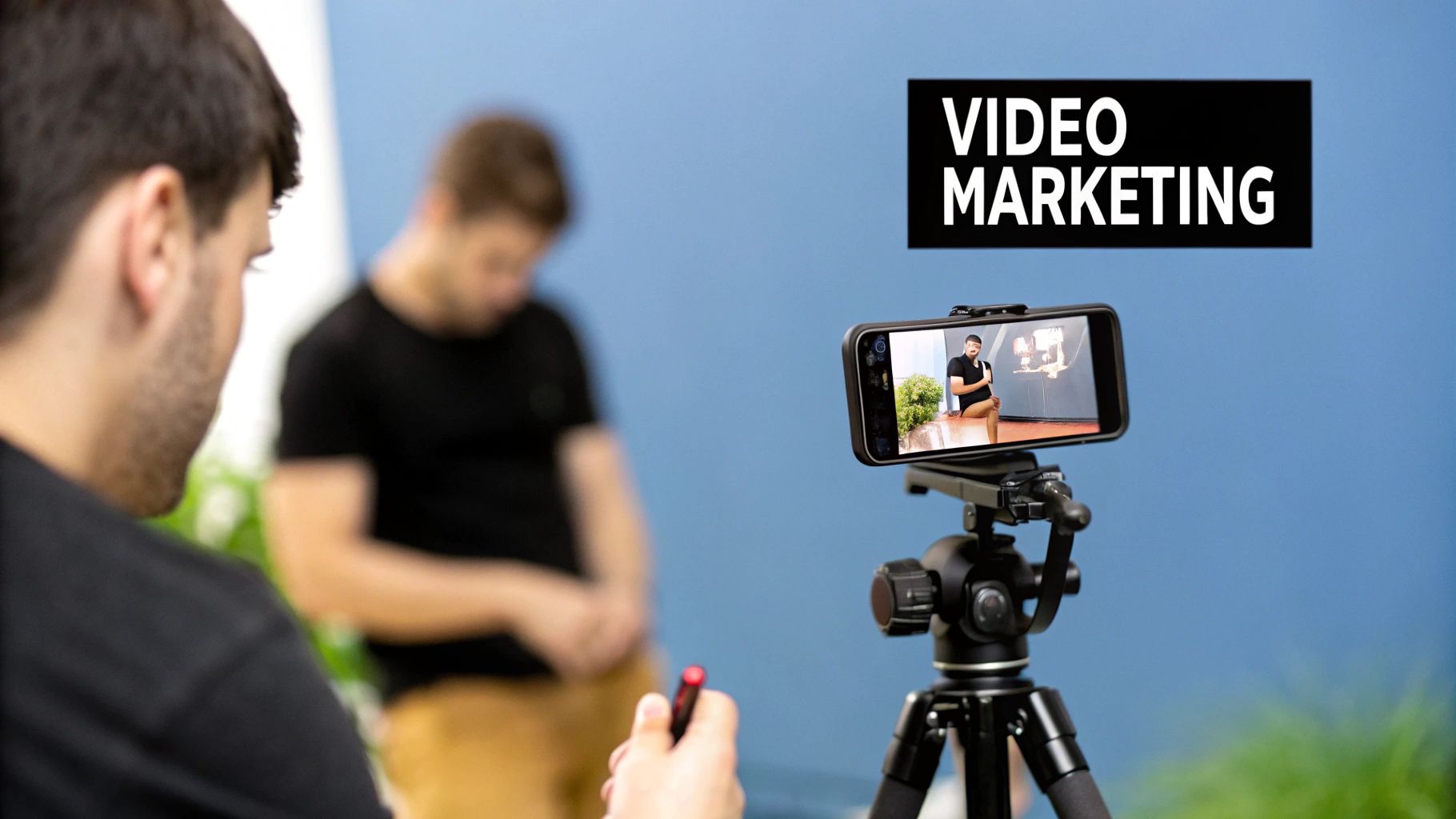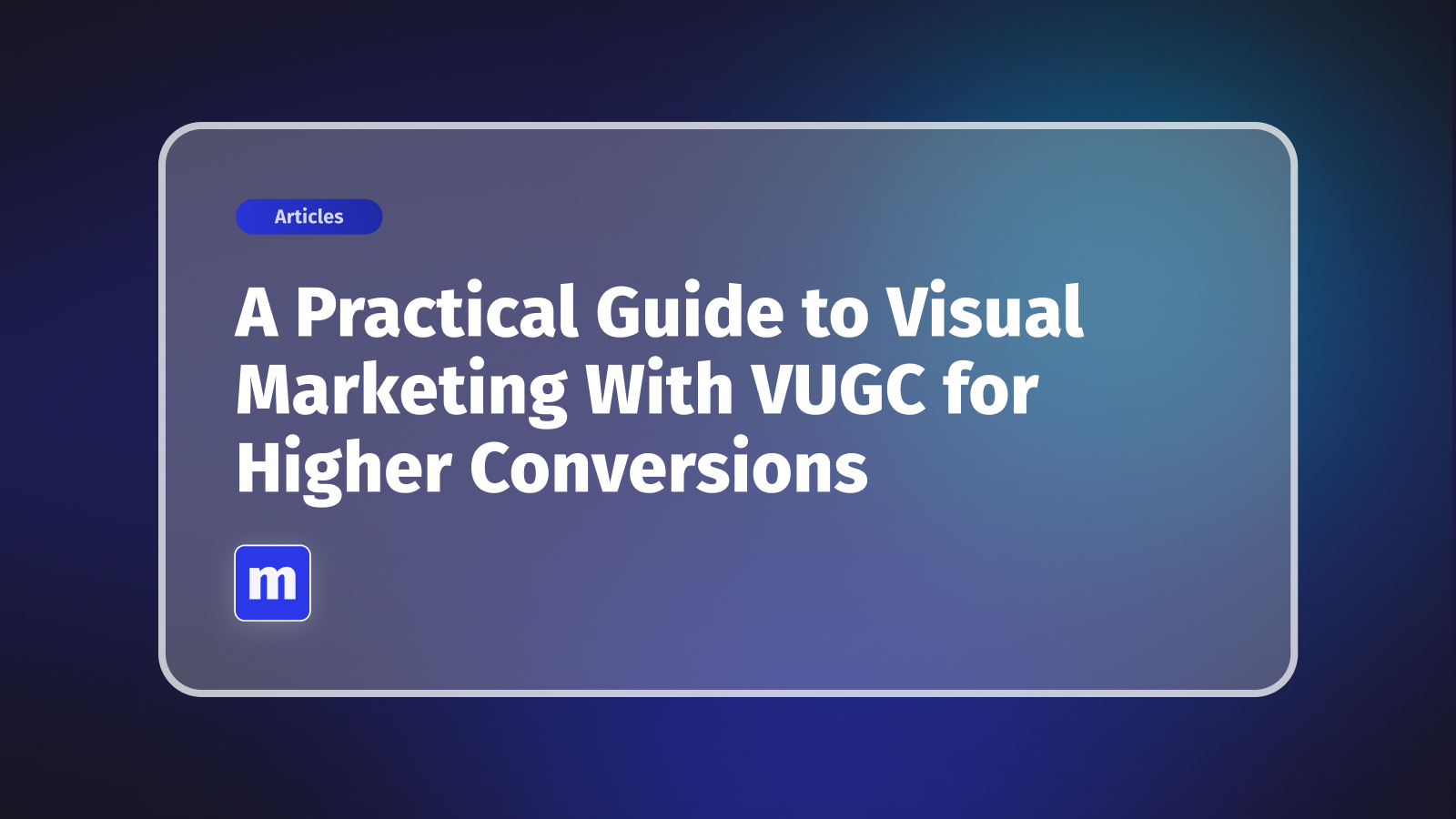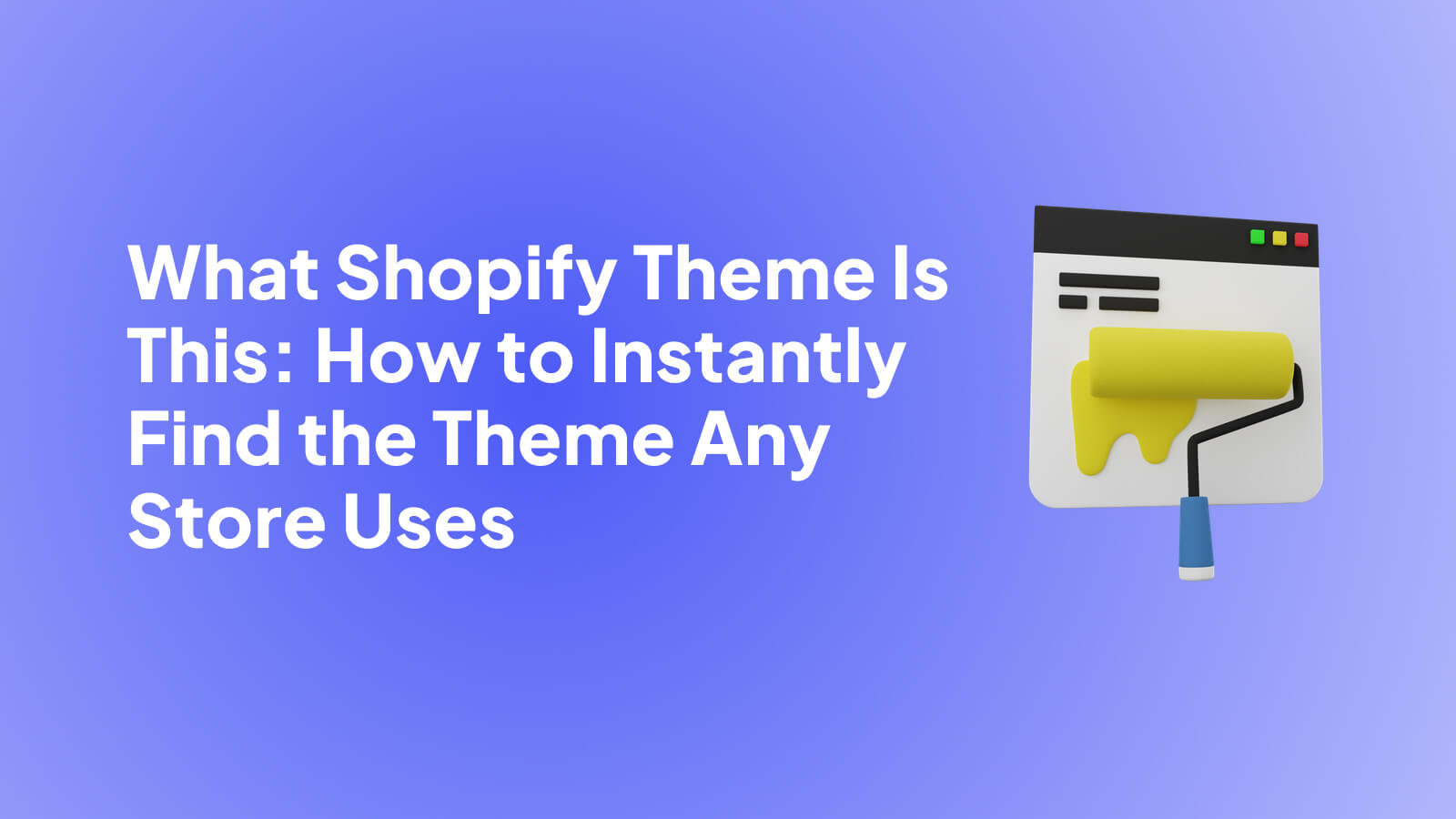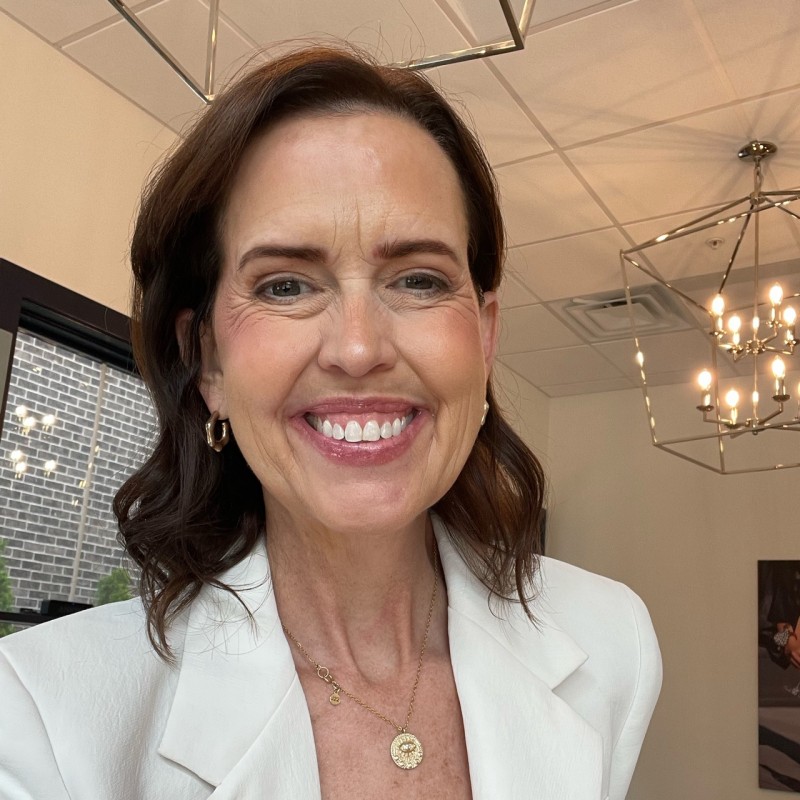
- Why Video Has Taken Over Social Media Marketing
- Choosing the Right Video for Each Platform
- Creating Video Content That Actually Converts
- Bringing AI and Modern Tools into Your Video Workflow
- Measuring the Metrics That Matter for Video
- Measuring the Metrics That Matter for Video
- Your Action Plan for Video Marketing Success
- Your Top Video Marketing Questions, Answered
Let's be honest: treating video as an "optional" part of your social media plan is a thing of the past. Today, video isn't just a piece of the puzzle; it's the very heart of a thriving digital strategy. It's about making and sharing videos on your social channels to hook your audience, get your brand name out there, and, most importantly, drive sales.
Think of video as the most powerful, eye-catching tool you have.
Why Video Has Taken Over Social Media Marketing
Picture your social media feed. It’s a crowded, noisy place. Text posts and static images are like posters on a wall—sure, some people might notice them, but they rarely make anyone stop and stare.
Video is different. It’s the lively street performer, the dynamic storefront display with lights and music. It has a story to tell, and it pulls people in. That’s the real magic of using video on social media; it stops the mindless scroll and turns it into a moment of genuine connection.
In a space where everyone is shouting for attention, video is what helps you get heard. It’s not just about racking up likes; it's about building real relationships that a simple photo just can't forge. Video lets you show emotion, prove your product’s worth, and tell your brand’s story in a way that actually sticks with people.

The numbers don't lie. Video isn't just a fun trend; it's a direct response to how people behave online, and the impact it has on the bottom line is undeniable.
The statistics below paint a clear picture of why video is no longer a "nice-to-have" but a core business driver.
Key Social Media Video Statistics at a Glance

These figures show that a strategic investment in video pays off across the entire customer journey, from initial discovery to the final sale.
The Real-World Impact on Your Brand’s Growth
The massive shift to video-first strategies is happening for a reason. And in a competitive world, that reason is results. For a deeper dive into the specific formats that work, check out our complete guide to creating video content for social media.
Here's the bottom line: brands using video are winning. It's not just about engagement; it's about tangible growth that you can see in your analytics and your bank account.
This is especially true for ecommerce brands, where video does the crucial job of bridging the gap between seeing a product online and experiencing it in person.
How Video Turns Views Into Revenue
For Shopify merchants, the return on investment from a smart video strategy is real and touches multiple parts of the business. It’s not just about getting more eyeballs on your content; it's about making the path from "I like that" to "I'll buy that" as short and simple as possible.
Here’s exactly how video makes that happen:
- It Builds Trust and Feels Real: Video lets you show the people behind the brand. A quick behind-the-scenes tour, a story from the founder, or a genuine customer testimonial creates a human connection that plain text can't match. People buy from people they trust.
- It Supercharges Your Engagement: Social media algorithms love content that keeps people on the platform. Since videos naturally hold attention longer than static posts, they get pushed to more feeds, which means more reach and visibility for you.
- It Shows Your Product’s True Value: Why write a long, boring product description when you can show it in action? A 30-second demo video can answer customer questions, handle objections, and highlight benefits far more effectively.
- It Drives Instant Purchases: Modern features like shoppable video tags make buying a seamless experience. Someone can see a product they love in your video, tap it, and head straight to checkout. The sales cycle gets dramatically shorter.
Ultimately, weaving video marketing into your social media strategy is about setting your brand up for the future. It’s about meeting modern customers where they are and connecting with them in the way they prefer.
Choosing the Right Video for Each Platform
Trying to use the same video across all your social media channels is a classic rookie mistake. It’s like wearing a tuxedo to a backyard barbecue—it just doesn't fit the vibe. Each platform has its own unwritten rules, its own culture, and its own audience expectations. The secret to effective video marketing for social media is tailoring your content to feel like it belongs wherever it’s posted.
Think of it this way: a fast-paced, trendy TikTok video is like a shot of espresso—it’s designed for a quick, powerful hit of energy and attention. On the other hand, a detailed product tutorial on YouTube is more like a slow-drip coffee, meant for someone who wants to sit down, learn, and really understand something. Using the right format for the right platform makes all the difference.
You have to get inside the head of the user on each app. Someone flicking through Instagram Stories is in a completely different mindset than someone searching for “how-to” videos on YouTube. Matching your video style to that mindset is your first big win.
The image below breaks down how getting video right can build from initial audience engagement all the way to real, measurable sales for your store.

As you can see, grabbing your audience’s attention is the foundational step that makes brand awareness and sales growth possible.
Instagram Reels and Stories: Your Dynamic Duo
Instagram gives you two powerhouse video tools: Reels and Stories. They’re both vertical and designed for mobile, but they do very different jobs for your Shopify store.
Instagram Reels are your showstoppers. These are short, looping clips engineered for discovery. The algorithm loves a good Reel and will push it out to people who don't even follow you yet.
Here’s where Reels shine:
- Product Demos: Show off your product in action with quick, eye-catching visuals.
- Jumping on Trends: Use trending audio or challenges to get a massive visibility boost and show off your brand’s personality.
- Quick Tips & Tricks: Share genuinely useful, bite-sized advice related to what you sell.
Instagram Stories, meanwhile, are all about connecting with your existing community. They only last for 24 hours, which creates a feeling of "you had to be there" intimacy.
Use Stories to:
- Go Behind the Scenes: Show the real people and processes behind your brand. It doesn’t have to be polished; in fact, it's better if it isn't.
- Get Interactive: Run polls, quizzes, and Q&A sessions to pull your audience into a conversation.
- Announce Flash Sales: Drive serious urgency with limited-time offers that vanish.
TikTok vs. YouTube: The Entertainer and The Educator
While they're both video behemoths, TikTok and YouTube are worlds apart in how people use them. TikTok is the undisputed champion of short, addictive, algorithm-fed entertainment. YouTube is still the go-to library for deep, searchable, and educational videos.
For a Shopify brand, TikTok is your ultimate top-of-funnel machine. It's the place where you can get in front of millions of potential customers overnight, simply by being creative and tapping into a trend. Forget the hard sell here; it never works. The key is to "show, don't tell," creating content that feels like it was made by a real user.
On TikTok, your video isn’t an ad interrupting the entertainment—it is the entertainment. The brands that win get this. They create content that adds to the user’s feed instead of just trying to sell them something.
YouTube, whether you’re making long-form videos or Shorts, attracts a much more intentional viewer. People go there with a goal in mind—to solve a problem, learn a skill, or research a purchase. This makes it perfect for building trust and authority.
Think about creating videos like:
- In-Depth Product Guides: Don't just show what your product does; teach customers how to get the absolute most out of it.
- Raving Customer Reviews: Let your happy customers do the selling for you. Their stories build incredible social proof.
- Your Founder Story: Connect with people on a human level by sharing the "why" behind your brand.
Video length is another huge piece of the puzzle. While Instagram prefers snappy clips under 15 seconds, TikTok’s sweet spot is a bit longer, from 15 to 60 seconds. YouTube audiences, of course, are happy to watch videos well over a minute long. With the average US adult projected to watch 57 minutes of social video every day by 2028, mastering these formats is non-negotiable. For more data, check out these social media video trends from Sprout Social.
Social Media Platform Video Format Guide
To make things even clearer, here’s a quick-reference table to help you match your video content to the right platform. Think of this as your cheat sheet for making sure every video you create has the best possible chance to succeed.
PlatformBest Video FormatsOptimal LengthKey ObjectiveInstagramReels, Stories, Live, In-Feed VideosReels: 15-60 sec Stories: <15 secReels: Discovery & engagement Stories: Community buildingTikTokShort-form vertical videos15-60 secondsBrand awareness, entertainment, trend-spottingYouTubeLong-form, Shorts, LiveLong-form: 2-10+ min Shorts: <60 secEducation, tutorials, building authority, search visibilityFacebookIn-Feed Videos, Stories, Live, Reels1-3 minutesDriving traffic, community engagement, salesLinkedInNative Video, Thought Leadership30 seconds - 5 minutesProfessional networking, B2B marketing, brand authority
Remember, this is a starting point. The best way to find out what works is to test different formats and pay close attention to what your audience responds to. Don't be afraid to experiment
Creating Video Content That Actually Converts
Alright, let's get down to the fun part: turning your strategy into videos that actually do something for your business. A great social media video doesn't just rack up views; it gets real results. The whole point of video marketing for social media is to create content that stops someone mid-scroll, keeps them glued to the screen, and gives them a gentle nudge to take the next step—whether that's visiting your store, joining your email list, or hitting "add to cart."
To pull this off, your video has to be more than just a pretty moving picture. It needs to tell a story, spark an emotion, and give the viewer a crystal-clear reason to care. The best videos I've seen all nail three things: a magnetic story, powerful visuals, and great audio that all work together seamlessly.
The Hook, Story, Offer Framework
Let's be real: you have less than three seconds to grab someone's attention. That’s it. This is precisely why the Hook, Story, Offer (HSO) framework is a game-changer for social media. It’s a beautifully simple structure built for today's tiny attention spans.
- The Hook (Seconds 0-3): This is your scroll-stopper. Think of it as the opening scene of a movie. It could be a wild question, a shocking visual, or a bold claim that makes people stop and say, "Wait, what?"
- The Story (Seconds 4-20): Now you deliver on what the hook promised. This is the heart of your video. You're building a connection, showing off what makes your product amazing, or demonstrating how it solves a nagging problem.
- The Offer (Final Seconds): This is your call to action. No beating around the bush here. Be direct, be clear, and tell people exactly what you want them to do next.
Think of it as a mini-movie. The hook is the explosive opening, the story is the gripping plot, and the offer is the final scene that tells the audience where to go from here. Getting this rhythm down is the first big step toward making videos that move the needle. For a deeper dive, our guide on ecommerce video marketing explores other powerful frameworks, too.
Mastering Visuals and Audio on a Budget
You don't need a Hollywood budget to make great-looking videos. Seriously. The smartphone in your pocket is more than capable of creating professional-looking content that people will actually watch.
Your goal isn't cinematic perfection; it's clarity and connection. A well-lit, stable video shot on an iPhone will always outperform a shaky, dark video shot on a high-end camera.
Just focus on getting these three visual elements right:
- Good Lighting: Natural light is your best friend, and it's free! Just set up near a window. It provides soft, flattering light that makes everything—and everyone—look better.
- Stable Framing: Nobody wants to watch a shaky, nauseating video. A cheap tripod for your phone is one of the single best investments you can make. It instantly makes your videos look 10x more professional.
- On-Screen Text: So many people watch videos with the sound off. Use bold, readable captions and text overlays to hammer home your key points and tell your story visually.
Audio is the other half of the experience. Terrible sound can ruin even the most stunning video. A crisp voiceover or a perfectly chosen trending audio track can make a huge emotional impact and boost engagement. You don’t need a recording studio—just a quiet room and a simple clip-on mic will work wonders.
Real-World Examples That Drive Sales
The explosion of short-form video has completely changed the game. Clips under 60 seconds are delivering the best ROI right now. Just look at the data: Instagram Reels are watched nearly 139 million times per minute, which tells you people are hungry for this kind of content. And over on TikTok, the platform has a massive impact on what people buy, with almost half of its users making a purchase after seeing something on the app. You can find more stats like these in this report on 2025 video marketing statistics.
Let’s break down how smart ecommerce brands are using these ideas to make sales.
Example 1: The Product Demo
A skincare brand posts a 15-second Reel. The Hook: An extreme close-up of a common skin issue. The Story: It quickly cuts to someone applying their product, followed by that satisfying "after" shot, all set to an upbeat, trending song. The Offer: A simple text overlay reads, "Get the glow. Link in bio."
Example 2: The User-Generated Content (UGC)
A fashion brand reposts a TikTok from a happy customer. The Hook: The creator’s genuine, excited reaction as she unboxes a new dress. The Story: She tries it on, styles it a few different ways, and gushes about how amazing the fabric feels. The Offer: The brand simply adds a shoppable tag to the video, so viewers can buy that exact dress with a single tap.
These videos work because they feel real, they're easy to watch, and they make it incredibly easy for someone to buy. They entertain first and sell second—and that’s the secret to winning on social media today.
Bringing AI and Modern Tools into Your Video Workflow
Not too long ago, high-quality video production felt out of reach for anyone without a massive budget. That’s just not the case anymore. The right technology completely levels the playing field, helping you build a video creation process that's fast, efficient, and ready to scale.
Think of modern tools, especially Artificial Intelligence, as a co-pilot, not a replacement for your creativity. AI is brilliant at handling the tedious, time-consuming tasks that can bog down a project. This frees you up to focus on what really matters: telling a great story and connecting with your audience. By building a smart tech stack, your Shopify brand can produce professional-grade content in a fraction of the time, letting you compete with the biggest names in your niche.

AI as Your Creative Assistant
Artificial intelligence is already changing the game for video marketing on social media by automating huge chunks of the workflow. Instead of getting stuck in the weeds, you can use AI to speed everything up and even uncover creative angles you might have missed on your own.
Here are a few ways AI can step in as your right-hand assistant:
- Brainstorming and Scripting: Hitting a creative wall? AI tools can analyze what's trending and spit out video concepts, script outlines, or even full first drafts. It's a fantastic way to break through a block and keep your content calendar full.
- Automatic Captions: Most people watch social videos with the sound off, so captions are absolutely essential. AI-powered transcription can generate accurate subtitles in minutes—a job that used to take hours of painstaking manual work.
- Smart Editing: Some of the newer tools can actually analyze your raw footage and suggest the best clips, trim out awkward pauses, and recommend edits that will keep your viewers hooked.
The impact here is huge. We're seeing 90% of businesses using generative AI report significant time savings, and 73% are seeing higher engagement as a result. AI isn't just a novelty; it's delivering real results.
Don't overcomplicate AI. The goal is simple: do more with less. Let it handle the grunt work so you can pour your energy into the creative vision that only you can bring to life.
And it’s not just about video-specific software. General AI apps can also give your entire workflow a boost, from brainstorming ideas to analyzing performance. For teams on Apple hardware, exploring the best AI applications for Mac can reveal some amazing productivity hacks for the whole creative process.
Assembling Your Essential Video Tech Stack
Beyond AI, a few other tools are non-negotiable for a smooth, professional workflow. Putting together a solid tech stack ensures you have the right tool for every stage of the process, from a simple idea to a published video.
Your modern toolkit should include:
- Project Management Software: A tool like Asana, Trello, or Monday.com is your command center. It keeps your video projects organized, tracking everything from script approvals and shoot schedules to editing deadlines. Everyone on the team knows exactly what’s happening and when.
- Licensed Music Libraries: The perfect song can make a video, but using copyrighted music is a surefire way to get your content flagged or removed. A subscription to a service like Epidemic Sound or Artlist gives you a massive library of high-quality, royalty-free tracks. Problem solved.
- Stock Footage and Asset Platforms: You won't always have the time or budget for a full-scale custom shoot. Platforms like Storyblocks or Envato Elements are a lifesaver, offering professional video clips, graphics, and templates to fill the gaps and make your content look polished.
Measuring the Metrics That Matter for Video
Making great videos is just the starting line. If you’re not tracking how they perform, you're just throwing content into the void and hoping for the best. To really build a video strategy that moves the needle for your Shopify store, you have to look past simple view counts and dig into the data that actually impacts your bottom line.
Think of your analytics dashboard as your mission control. Every metric is a signal telling you what’s resonating with your audience, what’s falling flat, and why. Nailing this part isn’t just about tweaking content; it's about proving your return on investment and making smarter decisions with every video you publish.
Beyond Views: Are People Even Seeing Your Stuff?
First things first, you need to know if your videos are cutting through the noise. This first layer of metrics, often called "awareness metrics," tells you how many people your content is reaching. It’s the foundational check to see if you're getting in front of potential customers.
Here's what to look at:
- Impressions: This is how many times your video was shown in someone's feed. It doesn't mean they watched it—just that it was there on their screen.
- Reach: This is the number of unique people who saw your video. One person might see your video three times (3 impressions), but they only count as 1 for reach.
If you see a ton of impressions but your reach is low, it probably means your video is being shown to the same small group over and over. The real goal is to maximize reach and get your brand in front of as many new eyes as possible.
Gauging Interest: Do They Actually Care?
Okay, people are seeing your videos. The next big question is: do they care? Engagement metrics reveal how your audience is interacting with your content. This is where you find out if you're making a genuine connection or if people are just scrolling right past.
Engagement is the currency of social media. A video with high engagement tells the platform's algorithm that your content is valuable, which leads to greater organic reach.
Key engagement metrics to obsess over:
- Watch Time: The total, cumulative time people have spent watching your video. Social platforms love high watch times because it keeps users on their app longer, so they'll reward you for it.
- Audience Retention: This graph is pure gold. It shows you the percentage of viewers still watching at every single second of your video. See a huge drop-off in the first 3 seconds? Your hook isn't working. It's that simple.
- Shares: When someone shares your video, they’re putting their own reputation on the line to vouch for it. It's one of the strongest signals you can get that your content truly hit the mark.
A high retention rate on a product demo video is a massive buying signal. It means people are genuinely interested in what you have to offer. To go even deeper on this, check out our complete guide to video marketing analytics.
Connecting Video to Sales: Did It Make You Money?
For any Shopify merchant, this is where the rubber meets the road. Conversion metrics draw a direct line from your video marketing efforts to real business results, like traffic and sales. This is how you prove that video isn't just a creative expense—it's a revenue-generating machine.
The essential conversion metrics for video are:
- Click-Through Rate (CTR): What percentage of viewers actually clicked the link you provided? Whether it’s in your bio, a caption, or an on-screen button, a high CTR means your video successfully motivated someone to take the next step.
- Add-to-Carts: On platforms with built-in shopping, this tracks how many people tossed a product into their cart right after watching. It's a fantastic indicator of immediate purchase intent.
- Conversion Rate: The ultimate metric. This is the percentage of viewers who followed through and made a purchase after clicking from your video.
When you look at all these metrics together, the full picture comes into focus. For instance, teams who use social listening tools to understand their audience are seeing up to double the confidence in their ROI measurements. You can discover insights from Talkwalker on social media statistics to learn more. By combining awareness, engagement, and conversion data, you can finally see exactly how that one viral video led to a huge spike in sales.
Your Action Plan for Video Marketing Success
Alright, let's get down to business. You've got the theory, now it's time to put it all into practice. This is where the rubber meets the road—a simple, no-fluff roadmap to take you from idea to execution. Think of the next few steps as your launch sequence for a video strategy that actually gets results.
We're going to walk through this in four clear phases. The goal here is to kill the overwhelm and give you a repeatable process you can rely on.

Phase 1: Define Your Goals
Before you even think about hitting that record button, you have to know why you're doing this. What, specifically, do you want these videos to accomplish for your business? If your goals are fuzzy, your results will be too.
The key is to connect your video goals to real business outcomes. For example, are you trying to:
- Boost Brand Awareness? Maybe your goal is to reach 50,000 new accounts each month.
- Drive Traffic to Your Site? You could aim for a 15% jump in clicks from your social channels.
- Increase Product Sales? A concrete goal might be to generate 100 direct sales from your video content.
Your goals are the North Star for your entire video strategy. They inform the kind of content you make, the platforms you choose, and how you measure success. Without them, you’re just creating content for the sake of it.
Phase 2: Plan Your Content Calendar
Consistency is the name of the game on social media. A content calendar is your secret weapon for staying organized and making sure you always have a steady flow of great video content ready to publish.
This doesn't have to be some overly complicated system. Honestly, a simple spreadsheet is often all you need.
- Brainstorm Core Topics: Start by listing video ideas that directly support the goals you just set. Product demos are great for sales, while behind-the-scenes content is perfect for building brand awareness.
- Match Videos to Platforms: Think about where each video makes the most sense. Quick, punchy tips are built for Instagram Reels, while longer, more detailed tutorials belong on YouTube.
- Schedule Everything Out: Set your publishing dates in advance. This creates a reliable posting rhythm that your audience can start to anticipate.
Phase 3: Establish Your Production Workflow
A smart, efficient production process is what separates the pros from the amateurs. It’s what allows you to create high-quality videos consistently without burning out. This is your assembly line for turning ideas into finished videos.
Your workflow should map out every step of the journey:
- Scripting & Storyboarding: This can be as simple as a quick outline of key messages and shots.
- Filming: The actual recording. Focus on getting the basics right, like good lighting and a steady camera.
- Editing: This is where you'll assemble the clips, add music, and pop in any text or captions.
- Approval: A quick final check to make sure everything looks good and aligns with your brand.
Phase 4: Distribute and Analyze
Your job isn't done once the video goes live. In fact, some of the most important work is just beginning. Smart distribution and sharp analysis are what separate good content from a great marketing asset.
First, push your video out across all your relevant channels to get as many eyes on it as possible.
Then, make it a habit to check your analytics every week. Are the metrics lining up with the goals you set in Phase 1? If you made a video to drive traffic but the click-through rate is low, it’s time to dig in and figure out why. This constant feedback loop of creating, measuring, and learning is the real secret to winning with video marketing for social media. The right tech can make this process a whole lot smoother; you can learn more about the available tools by exploring different shoppable video platforms.
Your Top Video Marketing Questions, Answered
Alright, even with the best strategy in hand, you're going to have questions. That's totally normal. Let's walk through some of the most common things Shopify merchants ask when they first dip their toes into social media video.
How Much Do I Really Need to Spend on Video?
This is the big one, isn't it? The honest answer is that it really depends, but you can absolutely start with $0. Seriously. Your smartphone and a free editing app like CapCut are all you need to get going. Initially, your biggest investment is going to be your time, not your money.
Once you start seeing some traction, you can think about scaling up your budget in stages:
- Getting Started ($50 - $200): A decent microphone and a simple ring light. These two things alone will make your videos look and sound ten times better, and they won't break the bank.
- Leveling Up ($200 - $1,000): Now you can start thinking about subscriptions for stock video, royalty-free music, or more powerful editing software. This is also a good range to start putting a little ad money behind your best videos to get them in front of more people.
- Going Pro ($1,000+): At this point, you might look into hiring a freelance video editor or a content creator to take some of the production work off your plate. This frees you up to think bigger picture.
The real secret is to start small, figure out what works for your audience, and then reinvest the profits back into your video efforts. Don't let a tiny budget hold you back—creativity will always beat cash.
Do I Need a Fancy Camera and Professional Gear?
Nope. Not at all. Your smartphone is more than powerful enough to create fantastic video for social media.
In fact, sometimes a video that looks too slick and professionally produced can actually hurt your performance on platforms like TikTok and Instagram Reels. People on those apps crave authenticity, not a high-budget commercial. A raw, genuine video shot on a phone often feels more trustworthy.
Forget the expensive gear for now. Just focus on the basics: get a cheap tripod to keep your phone steady, use natural light from a window whenever you can, and make sure your audio is clear. A well-lit, stable video from an iPhone will always outperform a shaky, poorly lit video from a $5,000 camera.
I'm Stuck. What Kinds of Videos Should I Even Make?
If you're drawing a blank, here's a simple trick: go through your customer service emails and DMs. Every single question a customer has asked you is a fantastic idea for a video. You already know people are curious about it!
To get the ball rolling, here are a few video styles that work for pretty much any online store:
- Show, Don't Tell: Film a quick demo of your product in action. How does it work? What problem does it solve? Let people see it for themselves.
- Pull Back the Curtain: Give a little behind-the-scenes tour. Introduce your team, show how you pack orders, or share a bit of your design process. This stuff builds a real human connection with your brand.
- Let Your Customers Do the Talking: Found a great video from a customer using your product? Share it! User-generated content (UGC) is marketing gold because it’s authentic social proof.
- Teach Something Useful: Share a quick tip or a bit of advice related to what you sell. If you sell coffee beans, make a 30-second video on the perfect pour-over. This positions you as an expert and gives people a reason to follow you.
Ready to turn your best social videos into sales? Moast lets you add beautiful, shoppable video galleries to your Shopify store in just a few minutes, completely free. Showcase your best TikToks and Reels to build trust and drive conversions. Get Moast for free and start today.
Related content
Turn your social content into a revenue channel
Turn your TikToks and Reels into shoppable videos and boost conversions by 3.5x.












